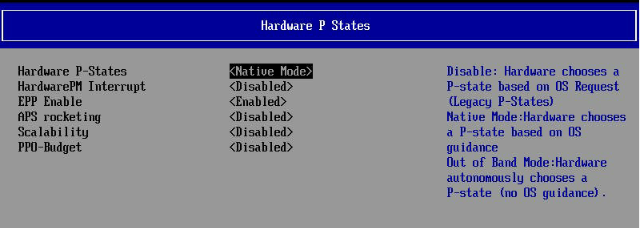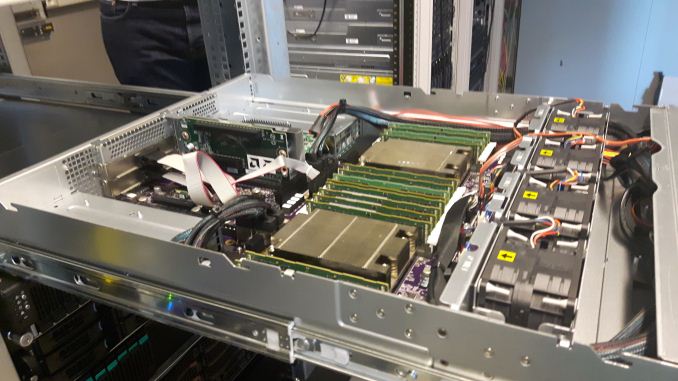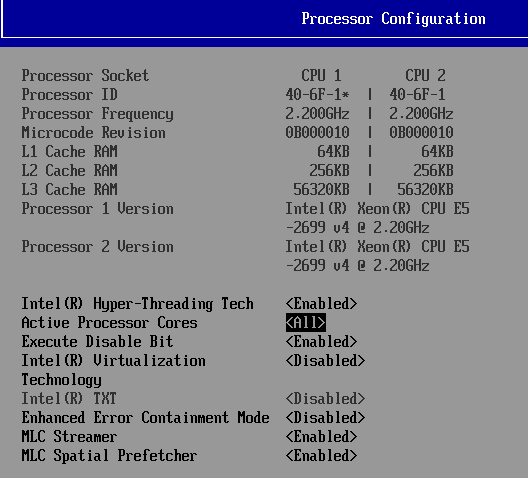Sizing Up Servers: Intel's Skylake-SP Xeon versus AMD's EPYC 7000 - The Server CPU Battle of the Decade?
by Johan De Gelas & Ian Cutress on July 11, 2017 12:15 PM EST- Posted in
- CPUs
- AMD
- Intel
- Xeon
- Enterprise
- Skylake
- Zen
- Naples
- Skylake-SP
- EPYC
Testing Notes
For the EPYC launch, AMD sent us their best SKU: the EPYC 7601. Meanwhile Intel gave us a choice between the top bin Xeon 8180 and the Xeon 8176. Considering that the latter had 165-173W TDP, similar to AMD's best EPYC, we felt that the Xeon 8176 was the best choice.
Unfortunately, our time testing the two platforms has been limited. In particular, we only received AMD's EPYC system last week, and the company did not put an embargo on the results. This means that we can release the data now, in time to compare it to the new Skylake-SP Xeons, however it also means that we've only had a handful of days to work with the platform before writing all of this up for today's embargo. We're confident in the data, but it means that we haven't had a chance to tease out the nuances of EPYC quite yet, and that will have to be something we get to in a future article.
Meanwhile we should note that we've had to retire the bulk of our historical benchmark data, as we upgraded both our compiler and OS (see below). Due to this, we only had a very limited amount of time to run additional systems, and for that reason we've opted include Intel's Xeon E5-2690. The Sandy Bridge-EP processor is about 5 years old, and for customers who aren't upgrading their servers every single generation, it's these servers that we believe are most likely to get upgraded in this round. So for server managers looking at finally buying into new hardware, you can get an idea of much return of investment you get.
Benchmark Configuration and Methodology
All of our testing was conducted on Ubuntu Server "Xenial" 16.04.2 LTS (Linux kernel 4.4.0 64 bit). The compiler that ships with this distribution is GCC 5.4.0.
You will notice that the DRAM capacity varies among our server configurations. The reason is that we had little time left before today's launch embargo. Removing any hardware is always a risk, so we decided to run our tests without significantly changing the internal hardware of the systems we received from AMD and Intel (SSDs were still replaced). As far as we know, all of our tests fit in 128 GB, so DRAM capacity should not have much influence on performance. But it wil have a impact on total energy consumption, which we will discuss.
Last but not least, we want to note how the performance graphs have been color-coded. Orange is AMD's EPYC, dark blue is Intel's best (Skylake-SP), and light blue is the previous generation Xeons (Xeon E5-v4) . Gray has been used for the soon-to-be-replaced Xeon v1.
Intel's Xeon "Purley" Server – S2P2SY3Q (2U Chassis)
| CPU | Two Intel Xeon Platinum 8176 (2.1 GHz, 28c, 38.5MB L3, 165W) |
| RAM | 384 GB (12x32 GB) Hynix DDR4-2666 |
| Internal Disks | SAMSUNG MZ7LM240 (bootdisk) Intel SSD3710 800 GB (data) |
| Motherboard | Intel S2600WF (Wolf Pass baseboard) |
| Chipset | Intel Wellsburg B0 |
| BIOS version | 9/02/2017 |
| PSU | 1100W PSU (80+ Platinum) |
The typical BIOS settings can be seen below; we enabled hyperthreading and Intel virtualization.
AMD EPYC 7601 – (2U Chassis)
Five years after our "Piledriver review", a new AMD server arrives in the Sizing Servers Lab.
| CPU | Two EPYC 7601 (2.2 GHz, 32c, 8x8MB L3, 180W) |
| RAM | 512 GB (16x32 GB) Samsung DDR4-2666 @2400 |
| Internal Disks | SAMSUNG MZ7LM240 (bootdisk) Intel SSD3710 800 GB (data) |
| Motherboard | AMD Speedway |
| BIOS version | To check. |
| PSU | 1100W PSU (80+ Platinum) |
Intel's Xeon E5 Server – S2600WT (2U Chassis)
| CPU | Two Intel Xeon processor E5-2699v4 (2.2 GHz, 22c, 55MB L3, 145W) Two Intel Xeon processor E5-2690v3 (2.3 GHz, 14c, 35MB L3, 120W) |
| RAM | 256 GB (16x16GB) Kingston DDR-2400 |
| Internal Disks | SAMSUNG MZ7LM240 (bootdisk) Intel SSD3700 800 GB (data) |
| Motherboard | Intel Server Board Wildcat Pass |
| BIOS version | 1/28/2016 |
| PSU | Delta Electronics 750W DPS-750XB A (80+ Platinum) |
The typical BIOS settings can be seen below.
HP-G8 (2U Chassis) - Xeon E5-2690
| CPU | Two Intel Xeon processor E5-2690 (2.9GHz, 8c, 20MB L3, 135W) |
| RAM | 512 GB (16x32GB) Samsung DDR-3 LR-DIMM 1866 MHz @ 1333 MHz |
| Internal Disks | SAMSUNG MZ7LM240 (bootdisk) Intel SSD3700 800 GB (data) |
| Motherboard | HP G8 |
| BIOS version | 9/23/2016 |
| PSU | HP 750W (Gold) |
Other Notes
Both servers are fed by a standard European 230V (16 Amps max.) power line. The room temperature is monitored and kept at 23°C by our Airwell CRACs.














219 Comments
View All Comments
StargateSg7 - Sunday, August 6, 2017 - link
Maybe I'm spoiled, but to me a BIG database is something I usually deal with on a daily basissuch as 500,000 large and small video files ranging from two megabytes to over a PETABYTE
(1000 Terabytes) per file running on a Windows and Linux network.
What sort of read and write speeds do we get between disk, main memory and CPU
and when doing special FX LIVE on such files which can be 960 x 540 pixel youtube-style
videos up to full blown 120 fps 8192 x 4320 pixel RAW 64 bits per pixel colour RGBA files
used for editing and video post-production.
AND I need for the smaller files, total I/O-transaction rates at around
OVER 500,000 STREAMS of 1-to-1000 64 kilobyte unique packets
read and written PER SECOND. Basically 500,000 different users
simultaneously need up to one thousand 64 kilobyte packets per
second EACH sent to and read from their devices.
Obviously Disk speed and network comm speed is an issue here, but on
a low-level hardware basis, how much can these new Intel and AMD chips
handle INTERNALLY on such massive data requirements?
I need EXABYTE-level storage management on a chip! Can EITHER
Xeon or EPyC do this well? Which One is the winner? ... Based upon
this report it seems multiple 4-way EPyC processors on waterblocked
blades could be racked on a 100 gigabit (or faster) fibre backbone
to do 500,000 simultaneous users at a level MUCH CHEAPER than
me having to goto IBM or HP for a 30+ million dollar HPC solution!
PixyMisa - Tuesday, July 11, 2017 - link
It seems like a well-balanced article to me. Sure the DB performance issue is a corner case, but from a technical point of view its worth knowing.I'd love to see a test on a larger database (tens of GB) though.
philehidiot - Wednesday, July 12, 2017 - link
It seems to me that some people should set up their own server review websites in order that they might find the unbiased balance that they so crave. They might also find a time dilation device that will allow them to perform the multitude of different workload tests they so desire. I believe this article stated quite clearly the time constraints and the limitations imposed by such constraints. This means that the benchmarks were scheduled down to the minute to get as many in as possible and therefore performing different tests based on the results of the previous benchmarks would have put the entire review dataset in jeopardy.It might be nice to consider just how much data has been acquired here, how it might have been done and the degree of interpretation. It might also be worth considering, if you can do a better job, setting up shop on your own and competing as obviously the standard would be so much higher.
Sigh.
JohanAnandtech - Thursday, July 13, 2017 - link
Thank you for being reasonable. :-) Many of the benchmarks (Tinymembench, Stream, SPEC) etc. can be repeated, so people can actually check that we are unbiased.Shankar1962 - Monday, July 17, 2017 - link
Don't go by the labs idiotUnderstand what real world workloads are.....understand what owning an entire rack means ......you started foul language so you deserve the same respect from me......
roybotnik - Wednesday, July 12, 2017 - link
EPYC looks extremely good here aside from the database benchmark, which isn't a useful benchmark anyways. Need to see the DB performance with 100GB+ of memory in use.CarlosYus - Friday, July 14, 2017 - link
A detailed and unbiased article. I'm awaiting for more tests as testing time passes.3.2 Ghz is a moderate Turbo for AMD EPYC, I think AMD could push it further with a higher thermal envelope i/o 14 nm process improvement in the coming months.
mdw9604 - Tuesday, July 11, 2017 - link
Nice, comprehensive article. Glad to see AMD is competitive once again in the server CPU space.nathanddrews - Tuesday, July 11, 2017 - link
"Competitive" seems like an understatement, but yes, AMD is certainly bringing it!ddriver - Tuesday, July 11, 2017 - link
Yeah, offering pretty much double the value is so barely competitive LOL.